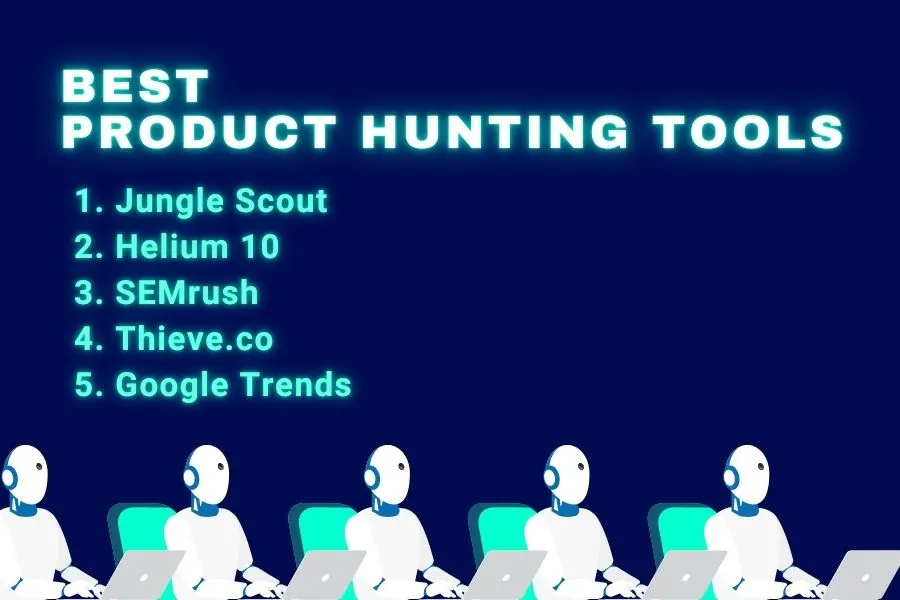Table of Contents
Introduction
As Ahmad Afridi, a digital marketer, often emphasizes, the foundation of a successful online business lies in selecting the right products to sell. The marketplace is saturated, and without proper Product Research Techniques, even the best ideas can falter. This blog aims to equip you with the best product hunting tools, product research techniques, and product discovery tools which ensuring you make informed decisions that drive sales and growth.
Best Product Hunting Tools

Choosing the right tools is important in identifying profitable products. Here are some of the Best Product Hunting Tools for 2024:
1. Jungle Scout
Jungle Scout remains a favorite among Amazon sellers. It offers comprehensive data on product sales, competition, and trends. With features like the Product Database and Keyword Scout, Jungle Scout simplifies the process of finding high-demand, low-competition products.
Key Features:
- Extensive product database
- Real-time sales estimates
- Keyword research tools
How to Use:
- Use the Product Database to find products with high sales and moderate competition.
- Research keywords using Keyword Scout to understand customer search behavior.
- Leverage the Chrome Extension to analyze competitor listings and estimate sales directly on Amazon.
2. Helium 10
Helium 10 is another powerhouse tool tailored for Amazon FBA sellers. It provides a suite of tools for product research, keyword optimization, and listing management.
Key Features:
- Black Box for product research
- Cerebro for keyword research
- Market Tracker for competitive analysis
How to Use:
- Use Black Box to find product ideas that fit your criteria (search volume, profit margins, etc.).
- Research keywords with Cerebro to optimize your product listings for discoverability.
- Monitor competitor activity and trends with Market Tracker to stay ahead of the curve.
3. SEMrush
While primarily known for SEO, SEMrush is invaluable for product research. Its comprehensive analytics on search trends and competitor strategies can uncover niche products with high potential.
Key Features:
- Keyword research and trend analysis
- Competitor analysis
- Market insights
How to Use:
- Research keywords using SEMrush to identify potential products with high search volume and low competition.
- Analyze competitor websites and listings to discover product gaps and selling points.
- Explore market insights to uncover trends and identify emerging product categories.
4. Thieve.co
Thieve.co is a curated platform that highlights trending products from AliExpress. It’s perfect for dropshippers looking for unique and popular items without extensive research.
Key Features:
- Curated product selections
- High-quality product images
- User ratings and reviews
How to Use:
- Browse Thieve.co’s curated product lists to discover trending items on AliExpress.
- Evaluate user ratings and reviews to understand customer sentiment for identified products.
- Explore product details and images to assess quality and potential for success.
5. Google Trends
Google Trends is a free tool which show product searching trend and you can also compare them. It helps in identifying seasonal trends and emerging product interests.
Key Features:
- Trend analysis over different time frames
- Regional interest data
- Related queries and topics
How to Use:
- Use Google Trends to identify seasonal trends and emerging product interests.
- Explore regional interest data to see if demand for a product exists in your target market.
- Analyze related searches and topics to identify potential variations or complementary products.
Product Hunting Techniques
Effective Product Hunting Techniques go beyond just using the right tools. Here are some strategies to enhance your product discovery process:
1. Niche Exploration
Focusing on a specific niche can reduce competition and cater to a targeted audience. Use tools like Jungle Scout or Helium 10 to explore niches with growing demand but manageable competition.
Example: A seller using Jungle Scout to identify a growing niche in eco-friendly kitchenware.
2. Trend Analysis
Staying updated with market trends is crucial. Utilize Google Trends and SEMrush to monitor what’s gaining traction. For instance, the rise of eco-friendly products can guide you toward sustainable merchandise.
Example: A seller using Google Trends to notice a surge in interest for plant-based protein products.
3. Competitor Analysis
Understanding what your competitors are selling can uncover gaps in the market. Analyze their product offerings, customer reviews, and pricing strategies to identify opportunities.
Example: A seller analyzing Amazon reviews for a top-selling fitness tracker to identify potential improvements for their own product.
4. Customer Feedback
Listening to your customers can provide invaluable insights. Platforms like Amazon reviews or social media can highlight what customers love or dislike, guiding your product selection.
Example: A seller reading customer comments on their social media posts to understand the most common pain points and address them with their next product.
5. Social Media Mining
Social platforms are goldmines for trending products. Tools like BuzzSumo can help identify popular content and products that resonate with audiences.
Example: A seller using BuzzSumo to find popular articles about minimalist fashion and identify potential product ideas, such as capsule wardrobes or minimalist accessories.
Product Research Techniques
Once you’ve identified potential products, thorough Product Research Techniques ensure their viability:
1. Market Demand Assessment
Evaluate the demand for a product using sales data from platforms like Amazon or eBay. High sales volumes often indicate strong market demand.
Example: Analyzing Amazon bestseller lists for a specific product category to gauge demand.
2. Competitive Analysis
Assess the competition by analyzing the number of sellers, product reviews, and overall market saturation. A highly competitive market may require a unique selling proposition (USP) to stand out.
Example: Using tools like SEMrush or Ahrefs to analyze competitor keywords, backlinks, and traffic.
3. Profit Margin Calculation
Calculate the potential profit by considering all costs, including manufacturing, shipping, and platform fees. Tools like Profit Bandit can assist in estimating profitability.
Example: Using a spreadsheet to calculate costs (e.g., materials, labor, shipping) and revenue to determine profit margin.
4. Supplier Verification
Ensure reliability by vetting suppliers. Platforms like Alibaba offer supplier ratings and reviews, helping you choose trustworthy partners.
Example: Checking supplier ratings and reviews on platforms like Alibaba.
5. Legal Compliance
Verify that the product complies with all relevant regulations and standards in your target market to avoid legal issues.
Example: Consulting with a legal professional to ensure compliance with regulations like FDA (for food and drugs), FCC (for electronics), or CE (for European Union products).
Product Discovery Tools

In addition to hunting and research tools, Product Discovery Tools play a pivotal role in finding innovative products:
1. Product Hunt
Product Hunt is a community-driven platform where new products are launched daily. It’s a great place to discover innovative tech gadgets, apps, and other unique products.
Key Features:
- Daily product listings
- Community feedback
- Trend tracking
How to Use:
- Explore: Browse through the daily product listings to discover new and innovative products.
- Join the Community: Participate in discussions and share your feedback on products.
- Follow Trends: Keep an eye on the trending products to identify emerging trends.
2. Kickstarter
Kickstarter showcases innovative projects seeking funding. Browsing Kickstarter can inspire you with cutting-edge product ideas and trends.
Key Features:
- Project categories
- Funding status
- Creator profiles
How to Use:
- Discover Ideas: Browse through the various project categories to find unique and innovative product concepts.
- Analyze Trends: Identify popular funding campaigns to understand current trends and consumer preferences.
- Support Projects: Back projects that align with your interests and help bring them to life.
3. Pinterest
Pinterest is not just for inspiration; it’s also a powerful tool for discovering trending products. Analyzing popular pins can reveal consumer interests and emerging trends.
Key Features:
- Visual discovery
- Trend boards
- User engagement metrics
How to Use:
- Create Boards: Create boards for different product categories or trends.
- Pin Ideas: Pin images and products that inspire you.
- Analyze Trends: Track the popularity of your pins and identify trending topics.
4. Trend Hunter
Trend Hunter provides comprehensive reports on the latest trends across various industries. It’s an excellent resource for staying ahead of the curve.
Key Features:
- Trend reports
- Innovation insights
- Industry-specific trends
How to Use:
- Explore Trends: Browse through the latest trend reports to stay informed about industry developments.
- Analyze Insights: Gain deeper understanding of trends and their implications.
- Identify Opportunities: Use trend analysis to identify potential product ideas or market niches.
5. AliExpress Dropshipping Center
The AliExpress Dropshipping Center offers tools to discover trending products and analyze their performance, making it easier for dropshippers to select winning items.
Key Features:
- Product analytics
- Trend tracking
- Supplier insights
How to Use:
- Discover Products: Search for trending products and analyze their performance metrics.
- Evaluate Suppliers: Assess the reliability and quality of potential suppliers.
- Optimize Listings: Use product analytics to improve your product listings and increase sales.
Conclusion
Navigating the vast landscape of product hunting and research can be daunting, but with the right tools and techniques, you can streamline the process and make informed decisions. By leveraging the Best Product Hunting Tools like Jungle Scout and Helium 10, employing effective Product Hunting Techniques such as niche exploration and trend analysis, and utilizing robust Product Research Techniques, you position yourself for success in 2024’s competitive market.
Frequently Asked Questions (FAQs)
1. What are the Best Product Hunting Tools for 2024?
Top tools include Jungle Scout, Helium 10, SEMrush, Thieve.co, and Google Trends. These tools help find profitable products through sales data, trend analysis, and competition tracking.
2. How Does Jungle Scout Improve Product Hunting?
Jungle Scout offers features like Product Database and Keyword Scout, allowing users to find high-demand, low-competition products and analyze competitors directly on Amazon.
3. What Are Effective Product Hunting Techniques?
Key techniques include niche exploration, trend analysis, and competitor research. For example, using Google Trends to track rising interests like eco-friendly products can guide your selection.
4. How Does SEMrush Help with Product Research?
SEMrush provides keyword research, competitor analysis, and market insights, helping sellers find high-potential niche products and spot emerging trends.
5. Why Is Competitor Analysis Important?
Analyzing competitors’ listings and customer reviews helps you identify market gaps and improve your products. Tools like SEMrush and Helium 10’s Market Tracker are useful for this purpose.

